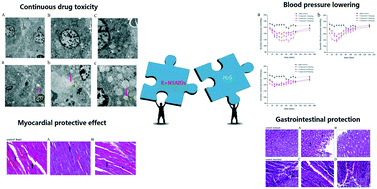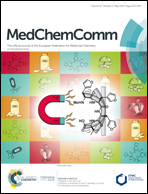Toxicities and beneficial protection of H2S donors based on nonsteroidal anti-inflammatory drugs†
Abstract
On the basis of our previous study, the H2S donors based on nonsteroidal anti-inflammatory drugs (NSAIDs) were further evaluated with regard to the following aspects: animal blood and urine analyses, liver and kidney toxicities, gastrointestinal protection, anti-hypertension, and myocardial protection. The test results showed that after the successive administration of the compound for 14 days, the number of white blood cells in the blood of rats reduced, and protein and leukocytes appeared in urine; further, α-lipoic-acid–acetaminophen ester (1) and ibuprofen–ADTOH ester (2) had a certain effect on the physiological tissue and function of rat liver, and their side-effects on the kidneys were obvious. However, when compared with NSAIDs as the precursors, the tested compounds displayed much fewer side-effects; particularly, for the gastrointestinal mucosa of rats, there were hardly any side-effects. Moreover, all the three compounds decreased blood pressures in spontaneously hypertensive rats in a concentration-dependent manner, even though this antihypertensive effect was weaker than those induced by nifedipine and captopril. In addition, three compounds protected H9c2 cells from injury via an antioxidation pathway; and they improved myocardial injury in spontaneously hypertensive rats. Compound 2 is the derivative of ibuprofen and has lower toxicity to rat cardiomyocytes than ibuprofen. Therefore, it may become a better substitute of ibuprofen in patients due to its lower cardiotoxicity.



 Please wait while we load your content...
Please wait while we load your content...